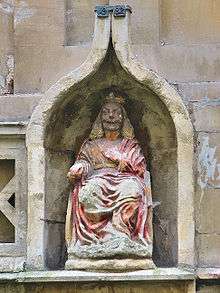Roman Baths (Bath)
| Roman Baths | |
|---|---|
|
The entrance to the Roman Baths | |
 Location within Somerset | |
| General information | |
| Town or city | Bath |
| Country | England |
| Coordinates | 51°22′51″N 2°21′34″W / 51.3809°N 2.3595°WCoordinates: 51°22′51″N 2°21′34″W / 51.3809°N 2.3595°W |
| Construction started |
Baths — Roman Building - 1894 |
| Completed | 1897 |
| Design and construction | |
| Architect | Building - John Wood, the Elder, John Wood, the Younger |
The Roman Baths complex is a site of historical interest in the English city of Bath. The house is a well-preserved Roman site for public bathing.
The Roman Baths themselves are below the modern street level. There are four main features: the Sacred Spring, the Roman Temple, the Roman Bath House and the Museum, holding finds from Roman Bath. The buildings above street level date from the 19th century.
The Baths are a major tourist attraction and, together with the Grand Pump Room, receive more than one million visitors a year.[1] It was featured on the 2005 TV program Seven Natural Wonders as one of the wonders of the West Country. Visitors can see the Baths and Museum but cannot enter the water. An audio guide is available in 12 languages.
How the hot springs form at the Bathhouse
.jpg)
The water which bubbles up from the ground at Bath falls as rain on the nearby Mendip Hills. It percolates down through limestone aquifers to a depth of between 2,700 and 4,300 metres (8,900 and 14,100 ft) where geothermal energy raises the water temperature to between 69 and 96 °C (156.2 and 204.8 °F). Under pressure, the heated water rises to the surface along fissures and faults in the limestone. This process is similar to an artificial one known as Enhanced Geothermal System which also makes use of the high pressures and temperatures below the Earth's crust. Hot water at a temperature of 46 °C (114.8 °F) rises here at the rate of 1,170,000 litres (257,364 imp gal) every day,[2] from a geological fault (the Pennyquick fault). In 1983 a new spa water bore-hole was sunk, providing a clean and safe supply of spa water for drinking in the Pump Room.[3]
History
The first shrine at the site of the hot springs was built by Celts,[5] and was dedicated to the goddess Sulis, whom the Romans identified with Minerva. Geoffrey of Monmouth in his largely fictional Historia Regum Britanniae describes how in 836 BC the spring was discovered by the British king Bladud who built the first Moorish baths.[6] Early in the 18th century Geoffrey's obscure legend was given great prominence as a royal endorsement of the waters' qualities, with the embellishment that the spring had cured Bladud and his herd of pigs of leprosy through wallowing in the warm mud.[7]
How the Romans used the building
The name Sulis continued to be used after the Roman invasion, leading to the town's Roman name of Aquae Sulis ("the waters of Sulis"). The temple was constructed in 60-70 AD and the bathing complex was gradually built up over the next 300 years.[8] During the Roman occupation of Britain, and possibly on the instructions of Emperor Claudius,[9] engineers drove oak piles to provide a stable foundation into the mud and surrounded the spring with an irregular stone chamber lined with lead. In the 2nd century it was enclosed within a wooden barrel-vaulted building,[5] and included the caldarium (hot bath), tepidarium (warm bath), and frigidarium (cold bath).[10] After the Roman withdrawal from Britain in the first decade of the 5th century, these fell into disrepair and were eventually lost due to silting up,[11] and flooding.[12] The Anglo-Saxon Chronicle suggests the original Roman baths were destroyed in the 6th century.[13]
About 130 curse tablets have been found. Many of the curses related to thefts of clothes whilst the victim was bathing.[14]
Redevelopment
The baths have been modified on several occasions, including the 12th century when John of Tours built a curative bath over the King's Spring reservoir and the 16th century when the city corporation built a new bath (Queen's Bath) to the south of the Spring.[15] The spring is now housed in 18th-century buildings, designed by architects John Wood, the Elder and John Wood, the Younger, father and son. Visitors drank the waters in the Grand Pump Room, a neo-classical salon which remains in use, both for taking the waters and for social functions. Victorian expansion of the baths complex followed the neo-classical tradition established by the Woods. In 1810 the Hot Springs failed and William Smith opened up the Hot Bath Spring to the bottom, where he found that the spring had not failed but had flowed into a new channel. Smith restored the water to its original course and the Baths filled in less time than formerly.[16]
The visitor entrance is via an 1897 concert hall by J M Brydon. It is an eastward continuation of the Grand Pump Room with a glass-domed centre and single-storey radiused corner.[17] The Grand Pump Room was begun in 1789 by Thomas Baldwin. He resigned in 1791 and John Palmer continued the scheme until its completion in 1799.[15] The elevation on to Abbey Church Yard has a centre piece of four engaged Corinthian columns with entablatures and pediment. It has been designated by Historic England as a grade I listed building.[18] The north colonnade was also designed by Thomas Baldwin.[19] The south colonnade is similar but had an upper floor added in the late 19th century.[20] The museum and Queen's Bath including the "Bridge" spanning York Street to the City Laundry were by Charles Edward Davis in 1889. It comprises a southward extension to the Grand Pump Room, in which some remains of the C17 Queen's Bath are merged.[21]
Museum
The museum houses artifacts from the Roman period including objects, which were thrown into the Sacred Spring, presumably as offerings to the goddess. These include more than 12,000 Roman currency coins which is the largest collective votive deposit known from Britain.[22] A gilt bronze head of the goddess Sulis Minerva, which was discovered nearby in 1727, is displayed.[23]
The Bath Roman Temple stood on a podium more than two metres above the surrounding courtyard, approached by a flight of steps. On the approach there were four large, fluted Corinthian columns supporting a frieze and decorated pediment above. The pediment, parts of which are displayed in the museum, is the triangular ornamental section, 26 feet (7.9 m) wide and 8 feet (2.4 m) from the apex to the bottom,[24] above the pillars on the front of the building. It featured the very powerful central image of the Gorgon’s head glowering down from a height of 15 metres on all who approached the temple.The great head itself has snakes entwined within its beard, wings above its ears, beetling brows and a heavy moustache[25] although there is some controversy about what this really represents as Gorgons are usually female.[26] An alternative interpretation sees the central head as the image of a water god such as the image of Oceanus,[27] and yet another as a Celtic sun god.[10] In early 2010 various stones on the pediment were conserved and rearranged.[28]
Also on display are the remains of the elaborate hypocaust heating system which served the sweat rooms.
In 2016 planning permission was received for a new learning centre aimed at school children and linked to the baths by a tunnel. Funding is being sought from the Heritage Lottery Fund and, if successful, it is hoped the centre will open in 2019.[29][30]
Conservation
The late 19th century carvings of Roman Emperors and Governors of Roman Britain on the terrace overlooking the Great Bath are particularly susceptible to the effect of acid rain and are being protected with a wash of a sacrificial shelter coat every few years.[31] Exhibits within the temple precincts are susceptible to warm air which had the effect of drawing corrosive salts out of the Roman stonework. To help reduce this, a new ventilation system was installed in 2006.[32]
In 2009 a grant of £90,000 was made to Bath and North East Somerset Council to contribute towards the cost of re-developing displays and improving access to the Roman Baths,[33] by the Department for Culture, Media and Sport/Wolfson Fund, which was established to promote improvements in Museums and Galleries in England.[34][35]
Water safety
Bath was charged with responsibility for the hot springs in a Royal Charter of 1591 granted by Elizabeth I. This duty has now passed to Bath and North East Somerset Council, who carry out monitoring of pressure, temperature and flow rates. The thermal waters contain sodium, calcium, chloride and sulphate ions in high concentrations.[36]
The water that flows through the Roman Baths is considered unsafe for bathing, partly due to its having passed through the still-functioning original lead pipes, and up until World War II, it was advertised on the basis of the radioactivity it contained. However, the more significant danger is now considered to be infectious diseases. In October 1978, a young girl swimming with the Bath Dolphins, a local swimming club, in the restored Roman Bath contracted meningitis and died,[37] leading to the closure of the bath for several years.[38] Tests showed that Naegleria fowleri, an extremely dangerous disease-causing amoeba, was in the water.[39] The newly constructed Thermae Bath Spa nearby, designed by Nicholas Grimshaw and Partners, and the refurbished Cross Bath allow modern-day bathers to experience the waters via a series of more recently drilled boreholes.
Gallery
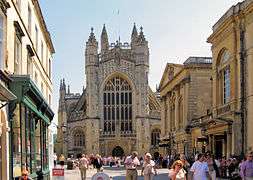 Bath Abbey West front, Roman Baths and Pump Room
Bath Abbey West front, Roman Baths and Pump Room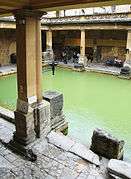 Great Bath
Great Bath The 'sacred pool'
The 'sacred pool'
 Spring overflow
Spring overflow
 Frigidarium (cold pool)
Frigidarium (cold pool)- Model of Roman Bath and Roman Temple of Sulis Minerva as they would have looked at their greatest extent in 4th century AD
 Model of Roman Bath
Model of Roman Bath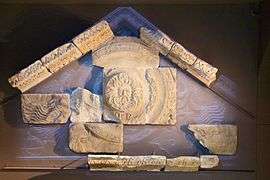 Bladud Gorgon head
Bladud Gorgon head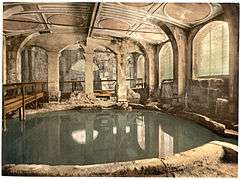 Circular Bath (Caldaria)
Circular Bath (Caldaria)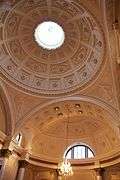 Roman Bath
Roman Bath- Caldarium. The floor has been removed to reveal the empty space which the hot air flowed through to heat the floor
 Roman Baths by Torchlight
Roman Baths by Torchlight The Great Bath is fed with hot water from the hot spring.
The Great Bath is fed with hot water from the hot spring.
- Victorian superstructure.
- Another view of the Victorian superstructure.
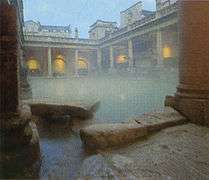 Steam rising from the Great Bath.
Steam rising from the Great Bath.- The Great Bath viewed from above.
References
- ↑ "Conservation in Action at the Roman Bath". Roman Baths Museum Web Site. Retrieved 1 November 2007.
- ↑ "Sacred Spring". Roman Baths Museum Web Site. Retrieved 31 October 2007.
- ↑ "Hot Water". Roman Baths Museum Web Site. Retrieved 31 October 2007.
- ↑ Tindall, Laurence. "Roman Baths King Bladud 1982". Retrieved 25 October 2008.
- 1 2 "The Roman Baths". Somerset Tourist Guide. Retrieved 1 November 2007.
- ↑ Monmouth, Geoffrey of; Thorpe, Lewis (1966). The History of the Kings of Britain. Harmondsworth, England: Penguin. p. 80. ISBN 0-14-044170-0.
- ↑ Borsay, Peter (2000). The Image of Georgian Bath, 1700-2000. Oxford, England: Oxford University Press. pp. 49–55. ISBN 0-19-820265-2.
- ↑ "City of Bath World Heritage Site Management Plan". Bath and North East Somerset. Archived from the original on 14 June 2007. Retrieved 1 November 2007.
- ↑ "The History of Plumbing — Roman and English Legacy". Plumbing World. Retrieved 1 November 2007.
- 1 2 "The Roman Baths". TimeTravel Britain. Retrieved 1 November 2007.
- ↑ "The Roman Baths". BirminghamUk.com. Retrieved 1 November 2007.
- ↑ Havinden, Michael (1981). The Somerset Landscape. The making of the English landscape. London: Hodder and Stoughton. p. 67. ISBN 0-340-20116-9.
- ↑ Bayley, Stephen (September 2007). "Is Bath Britain's most backward city?". The Observer. Retrieved 1 November 2007.
- ↑ Roger Tomlin (1988), Tabellae Sulis: Roman inscribed tablets of tin and lead from the sacred spring at Bath, Oxford.
- 1 2 "City of Bath World Heritage Site Management Plan — Appendix 3". Bath and North East Somerset Council. Archived from the original on 4 August 2007. Retrieved 1 November 2007.
- ↑ "William Smith — A brief survey of his work in the Bath". Bath Royal Literary and Scientific Instituition. Archived from the original on 13 October 2007. Retrieved 1 November 2007.
- ↑ "Concert Hall". Images of England. Retrieved 30 October 2007.
- ↑ "Grand Pump Room". Images of England. Retrieved 30 October 2007.
- ↑ "North Colonnade at Grand Pump Room". Images of England. Retrieved 30 October 2007.
- ↑ "South Colonnade at Grand Pump Room". Images of England. Retrieved 30 October 2007.
- ↑ "Museum & Queen's Bath including "Bridge" spanning York Street to City Laundry". Images of England. Retrieved 30 October 2007.
- ↑ "Objects from the spring". Roman Baths Museum Web Site. Retrieved 31 October 2007.
- ↑ "Minerva's Head". Roman Baths Museum Web Site. Retrieved 31 October 2007.
- ↑ Richmond, I. A.; Toynbee, J. M. C. (1955). "The Temple of Sulis-Minerva at Bath". The Journal of Roman Studies. The Journal of Roman Studies, Vol. 45. 45: 97–105. JSTOR 298749. doi:10.2307/298749.
- ↑ "New addition to Gorgon’s head". Bath and North East Somerset Council. Archived from the original on 4 December 2007. Retrieved 1 November 2007.
- ↑ "The Gorgon's head". Roman Baths Museum Web Site. Retrieved 31 October 2007.
- ↑ "Key objects of the collection". Roman Baths Museum Web Site. Retrieved 9 July 2015.
- ↑ "Bath Roman Baths repairs by Minerva". Minerva Stone Conservation. Retrieved 19 January 2010.
- ↑ "Planning permission granted for Archway Project at the Roman Baths". The Roman Baths. Retrieved 18 September 2016.
- ↑ "Roman Baths learning centre planning permission granted". BBC. Retrieved 18 September 2016.
- ↑ "Conserving the monument". Roman Baths Museum Web Site. Retrieved 31 October 2007.
- ↑ "Temple precinct work complete". Bath and North East Somerset Council. Archived from the original on 3 December 2007. Retrieved 1 November 2007.
- ↑ Morris, Steven (10 September 2010). "Bath cleansing brings Romans back to life". Guardian. Retrieved 10 September 2010.
- ↑ "Major redevelopment grant awarded to the Roman Baths". Press Release. Bath and North East Somerset. 27 August 2008. Retrieved 7 June 2012.
- ↑ "Summary of the successful institutions and projects" (PDF). Department for Culture, Media and Sport. 26 August 2008. Retrieved 29 August 2008.
- ↑ "Bath Hot Springs — Protection and Water Monitoring". Bath and North East Somerset Council. Archived from the original on 27 October 2007. Retrieved 1 November 2007.
- ↑ "History of Bath's Spa". Bath Tourism. Retrieved 9 January 2013.
- ↑ Crowther, Nigel B. (2007). Sport in Ancient Times. Greenwood Publishing Group. p. 98. ISBN 9780275987398. Retrieved 9 January 2013.
- ↑ Kilvington, Simon; Beeching, John (June 1995). "Identification and epidemiological typing of Naegleria fowleri with DNA probes" (PDF). Applied and Environmental Microbiology. 61 (6): 2071–2078. PMC 167479
 . PMID 7793928. Retrieved 9 January 2013.
. PMID 7793928. Retrieved 9 January 2013.
External links
| Wikimedia Commons has media related to Roman Baths (Bath). |
- Official website
- Conservation work within the baths.
- BBC 360 degree panorama
- 360 degree virtual Panomorphic Tour of the museum.
- History of Bath’s Spa.
